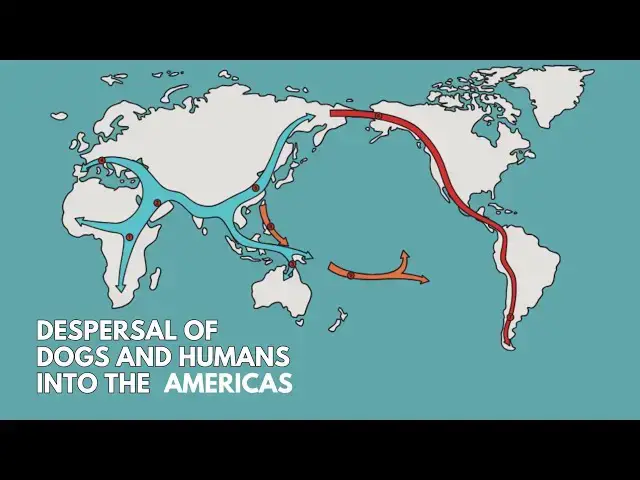https://www.pnas.org/lookup/suppl/doi:10.1073/pnas.2010083118/-/DCSupplemental
Show More Show Less View Video Transcript
0:00
[Music]
0:05
dogs were our earliest companions during
0:07
the prehistoric era ancient DNA studies
0:11
reveal the intertwined journey of humans
0:13
to the Americas and their loyal canine
0:15
friends offering a glimpse into the
0:18
fascinating partnership studies indicate
0:21
that dogs are closely linked to the
0:23
movements of human groups over time and
0:26
across different regions for example
0:28
when farmers migr from West Asia to
0:31
Europe a particular group of dogs with a
0:33
specific mitochondrial Hao group
0:35
accompanied them the first dogs in New
0:38
Zealand arrived with Polynesians and in
0:41
the North American Arctic dogs with a
0:43
unique mitochondrial DNA signature
0:46
joined paleo Inu groups around 5,000
0:49
years ago later when Inuit groups moved
0:52
into the same region about 1,000 years
0:55
ago a new population of dogs with
0:57
different DNA signatures appeared these
1:00
connections between human migrations and
1:03
specific dog lineages likely began soon
1:05
after dogs were domesticated from
1:07
Eurasian gy wolves however we're unsure
1:11
about the exact time and location of
1:13
this domestication process scientists
1:16
are trying to uncover the origins of
1:18
domestic dogs the first animals
1:21
domesticated during the pleistocene
1:23
epoch amidst environmental changes
1:26
studies suggest the original wolf
1:28
population that led to dogs is extinct
1:32
dog domestication likely occurred in
1:36
Eurasia despite using genetics and
1:38
archaeological evidence the timeline and
1:41
specifics of dog domestication are still
1:44
debated identifying early domestic dogs
1:47
from wolves is challenging as common
1:49
markers like tooth crowding and skull
1:52
size often don't provide clear
1:54
distinctions disputes arise over claims
1:56
of early domestic dogs at certain sites
1:59
due to difficulties in differentiation
2:01
from wolves the site of Bono Basel in
2:05
Germany stands out as the earliest
2:07
generally accepted remains of a domestic
2:09
dog dating back to approximately 15,000
2:13
years ago the distinct morphology and
2:16
genetics of this young dog set it apart
2:18
from local woles additional potential
2:21
domestic dog remains have been suggested
2:23
at various prehistoric sites including
2:26
some in Siberia and the Americas which
2:29
are still under
2:30
investigation scientists have studied
2:32
the DNA of many ancient and modern dogs
2:35
the analysis of nuclear DNA shows that
2:38
all dogs come from three main groups of
2:41
ancestors one from Western Eurasia
2:43
mostly in Europe India and Africa one
2:46
from East Asia like dingos and one from
2:49
the Arctic like huskys and ancient
2:51
American dogs these lineages were
2:53
established at least 11,000 years ago
2:57
when looking at mitochondrial DNA most
3:00
modern dogs fall into four main groups
3:02
called Hao groups a b c and d the
3:06
majority belong to a Hao group ancient
3:10
DNA studies found a unique Hao group A2B
3:13
in preon dogs in the America South of
3:16
the Arctic but it has almost disappeared
3:18
in modern dogs within A2B there are four
3:21
subgroups while a 2b1 is found all
3:24
across the Americas the others are more
3:27
localized scientists use molecular clock
3:30
analysis to estimate when these haa
3:32
groups split the oldest split within haa
3:35
group a between lineages a1b and A2 is
3:39
estimated to be around
3:41
22,800 years ago this suggests that dogs
3:44
were domesticated several thousand years
3:46
before they appeared in the
3:48
archaeological record this early
3:51
timeline suggests that dogs were likely
3:53
domesticated by the time humans migrated
3:56
into the Americas researchers have
3:58
traced native American ancestry back to
4:01
a population that diverged from an East
4:04
Asian ancestor around 30,000 years ago
4:07
around 24,000 years ago this population
4:10
split into two groups ancient paleo
4:13
saberians in Northeast Asia and the
4:15
basil Native Americans at approximately
4:18
24,000 years ago both groups received
4:22
gene flow from ancient North Siberians
4:25
during the last glacial maximum around
4:27
23,000 to 19 th000 years ago the basil
4:31
branch of Native Americans underwent a
4:33
period of isolation in Northeast Asia
4:35
known as the binan standstill lasting
4:38
possibly 2400 to 9,000 Years Around
4:42
21,000 years ago the basil Branch split
4:45
into ancient beringians and ancestral
4:48
Native Americans both populations
4:51
entered Eastern beringia present day
4:53
Alaska with the ancient Binion not
4:56
showing genomic evidence south of Alaska
4:58
after around 9,000 years ago the
5:01
ancestral Native Americans Diversified
5:03
around
5:05
15,700 years ago into northern and
5:08
southern branches the split between
5:11
northern and southern branches occurred
5:13
as the ancestral Native Americans moved
5:16
south from Alaska suggesting a route
5:18
along the Pacific coast rather than the
5:20
interior ice free Corridor which wasn't
5:23
yet suitable for human foragers the
5:25
estimated time of this split aligns with
5:28
archaeological evidence of people in the
5:30
Americas around 15,000 years ago
5:34
supporting the idea of a Pacific Coastal
5:36
route it's important to note that the
5:39
actual arrival date in the Americas
5:41
remains unclear as archaeological
5:44
evidence provides a minimum age and
5:46
genetic estimates offer a maximum value
5:49
once south of the ice sheets the
5:51
northern Branch had a limited Geographic
5:53
spread while the southern Branch
5:55
radiated throughout the hemisphere
5:57
diverging genetically around 14 ,000 100
6:00
years ago the relationship between the
6:03
migration of humans and dogs into the
6:06
Americas during the late Poli to scene
6:08
period is fascinating it suggests that
6:11
dogs may have accompanied the first
6:14
people entering the Americas and
6:16
explores the timeline of their
6:18
Divergence the Americas were settled by
6:21
humans relatively late and it's possible
6:23
that when people first arrived they had
6:26
dogs with them dogs could have played a
6:28
role in help humans quickly spread
6:31
throughout the region comparing the
6:32
timelines of dog and human populations
6:35
researchers found key points of
6:38
convergence the introduction of dogs in
6:40
the Americas is estimated using
6:42
mitochondrial data and it aligns with
6:45
the timing of human population splits
6:48
ancient American dogs excluding the
6:50
Arctic belong to the same lineage
6:53
suggesting they coales with a Siberian
6:55
dog lineage around 16.4 th000 years ago
6:59
this time frame coincides with the
7:01
peopling of the Americas the evidence
7:04
indicates that dogs likely cross the
7:06
bingel land bridge during the pleased to
7:08
scene reaching the Americas before later
7:11
human migrations the split between major
7:13
Native American lineages aligns with the
7:16
Divergence of dog lineages suggesting
7:18
they evolve together while both
7:21
ancestral Native Americans and ancient
7:23
beringian groups could have brought dogs
7:25
into the Americas archaeological
7:28
evidence hints that ancestral Native
7:30
Americans might have been the first
7:32
arriving before the distinctive ancient
7:34
beringians this suggests a connection
7:37
between the migration of people and dogs
7:39
into the Americas during this
7:42
period ancient DNA suggests that dog
7:45
domestication likely began in Siberia
7:48
during the late police to scene a period
7:50
around 26,000 to 19,000 700 years ago
7:55
this aligns with the time when humans
7:58
and their genetically diverse virgin
7:59
groups were present in Siberia and
8:02
Western binia the evidence indicates
8:05
that human populations in this region
8:07
were small and lived in relative
8:11
isolation the lack of significant gene
8:14
flow among these groups and the absence
8:17
of archaeological sites suggest limited
8:20
interaction with communities outside
8:22
Siberia as these populations
8:24
specifically the ancestors of Native
8:27
Americans crossed into the Americas they
8:29
brought dogs with them how did ancestral
8:32
Native Americans acquire dogs the
8:35
researchers proposed that dogs were
8:37
likely domesticated from a wolf
8:39
population in Siberia or Western binia
8:42
during the late place to scene before
8:44
ancestral Native Americans migrated into
8:47
the Americas among the various groups
8:50
present in Siberia during the last
8:52
glacial maximum researchers eliminate
8:55
some possibilities and suggest that the
8:57
ancient North Siberian Ians are the more
9:00
likely population to have initiated the
9:02
domestication process genomic analyses
9:05
of ancestral Native American individuals
9:08
at Siberian sites show evidence of gene
9:11
flow into both ancient Native American
9:14
and Western Eurasian
9:16
lineages this suggests a mechanism for
9:19
the transfer of dogs into different
9:21
groups supporting their movement both
9:23
East and West following domestication
9:26
the researchers propos that climatic
9:28
conditions during the last glacial
9:30
maximum brought human and wolf
9:32
populations into proximity within
9:34
refugial areas leading to increased
9:37
interactions Mutual Scavenging of kills
9:40
or wolves drawn to human campsites may
9:42
have initiated a shift in the
9:44
relationship between humans and wolves
9:47
eventually resulting in dog
9:50
domestication the evolving relationship
9:52
between humans and dogs has played a
9:55
crucial role in their successful Global
9:57
spread with more insights expected as
10:00
archaeological and scientific techniques
10:03
Advance thank you for watching
#Pets & Animals
#Pets
#Dogs
#Biological Sciences
#Ecology & Environment


